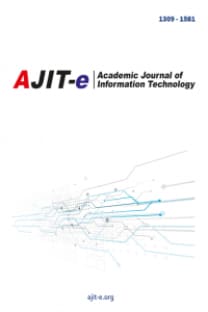Yeni Ağ Teknolojileri Bağlamında Yeni İletişim Ortamları ve Bilgi
Bu makalede yeni iletişim ortamları ve bilgi, yeni ağ teknolojileri bağlamında incelenmektedir. Yeni iletişim ortamları iletişim araştırmacıları açısından ilgi çekicidir. Çünkü sayısal, etkileşimli, hipermetinsel, sanal, ağ üstündedirler. Yeni iletişim ortamları içerik üretimi, politik katılım ve bilinçlenme gibi konularda bazı fırsatlar sunar. Diğer tüm mecralarda izlerkitle sayısı azalırken internette artması bununla ilişkilendirilebilir. Yeni iletişim ortamları ve bilgi toplumu incelenirken, bloglar örnek olarak düşünülerek bilgi, demokrasi ve ekonomi de ele alınabilir.
New Media and Knowledge in the Context of New Network Technologies
This paper, examines new media and information in the context of new network technologies. In terms of communication researchers, new communication technologies and media are interesting. Because they are digital, interactive, hypertextual, virtual, on the network. New media provides some opportunities such as content production, political participation and awareness. This, also, can be associated with decreasing number of audience in the media other than internet. When new media and knowledge economy are examined, information, democracy and economy can be addressed with the blogs as examples.
Keywords:
new media, new network technologies, knowledge, blog knowledge economy,
___
Aitchison, J. ve Lewis, D.M., (2003), New Media Language. London:RoutledgeBruns, Axel (2008) “The Future Is User-Led: The Path towards Widespread Produsage”. Fibreculture Journal, eprints.qut.edu.au/12902, Fibreculture Publications, Perth, WA.
Castells, M. (1996), The Rise of the Network Society. Cambridge, MA; Oxford: Blackwell Publishers.
Cummings, D. (2003) “Ideas, Intellectuals and the Public”, Critical Review of International Social and Political Philosophy, 6:4, s. 1–7
Daniel, S. (18.11.09), “Public Secrets.” Vectors Journal of Culture and Technology in a Dynamic Vernacular, vectors.usc.edu/issues/4/publicsecrets/, Erişim: 13.03.12
Deuze, M. (2007), “Convergence culture in the creative industries”, International Journal of Cultural Studies, 10:2, s.243-263
DiMaggio, P., Hargittai, E., Neuman, W.R. ve Robinson, J.P. (2001), “Social Implications of the Internet”, Annual Review of Sociology, Vol. 27, s.307-336
Fowler, R. (1991), Language in the News: Discourse and Ideology in the Press, London:Routledge.
Greatbatch, D., Hanlon, G., Goode, J., O'Cathain, A., Strangleman, T. ve Luff, D. (2005), “Telephone triage, expert systems and clinical expertise”, Sociology of Health & Illness, 27:6, s. 802–830.
Grossman, L. (25.12.06), “You — Yes, You — Are TIME's Person of the Year”, time.com/time/magazine/article/0,9171,1570810,00.html, Erişim: 13.03.12
Heise, U.K. (1997), Chronoschisms: Time, Narrative, and Postmodernism. Cambridge University Press. s. 7
Kolsaker, A., Lee-Kelley, L. (2006), “‘Mind the gap’: e-government and e-democracy”. İçinde: Proceedings of the 5th international conference on Electronic Government (EGOV'06), Maria A. Wimmer, Hans J. Scholl, Ake Grönlund, and Kim Viborg Andersen (Ed.). Springer-Verlag, Berlin, Heidelberg, s.96-106
Lewis, A. (2005. Wordweb dictionary, Linearity item, based on Princeton Wordnet database.
Lister, M, Dovey, J. Giddings, S. Grant, I. ve Kelly, K. (2009), New Media: a critical introduction. London:Routledge
Ludwig, M.D., Gilmore, G. (2005), Modern News Editing, s.14, Blackwell Publishing
Machlup, F. (1962), The Production and Distribution of Knowledge in the United States. Princeton: Princeton University Press
Manovich, L. (2003), “New Media from Borges to HTML” The New Media Reader içinde. s.13, (ed.) N. Wardrip-Fruin ve Nick Montfort. Cambridge, MA:MIT Press
Matheson, D. (2004), “Weblogs and the Epistemology of the News: Some Trends in Online Journalism”, New Media & Society, Ağustos 2004 6:4, s.443-468
Pickard, V.W. (2006), “Assessing the radical democracy of indymedia: discursive, technical, and institutional constructions”. Critical Studies in Media Communication, 25:1, s.19-38.
Spielmann, Y. (2008), Video: the reflexive medium, MIT Press
Stateofthemedia.org. (2011), “Key Findings”, stateofthemedia.org/2011/overview-2/keyfindings, Erişim: 13.03.12
Tenhunen, S. (2008), “Mobile technology in the village: ICTs, culture, and social logistics in India”. Journal of the Royal Anthropological Institute, 14:3, s.515–534
Tsekeris, C. (2010), “Reflections on Reflexivity: Sociological Issues and Perspectives”, Contemporary Issues, 3(1), s.28-37.
Vatrapu, R., Robertson, S. P. ve Dissanayake, W. (2008), “Are political weblogs public spheres or partisan spheres?”, International Reports on Socio-Informatics, 5(1): s.7–26
Wardrip-Fruin, N. ve Montfort, N. (ed.). (2003), The New Media Reader. Cambridge, MA:MIT Press
We Media (2003), “Chapter 1: Introduction to participatory journalism” hypergene.net/wemedia/weblog.php?id=P36, Erişim: 13.03.12
Worldometers.info, (2012), “Blog posts written today”, www.worldometers.info/blogs, Erişim: 13.03.12
- Yayın Aralığı: Yılda 4 Sayı
- Yayıncı: AKADEMİK BİLİŞİM ARAŞTIRMALARI DERNEĞİ
Sayıdaki Diğer Makaleler
‘Süper’ Avm İçin ‘Hiper’ Teknoloji Kullanımı
Müşteri İlişkileri Açısından Alışveriş Merkezlerinde Akıllı Teknoloji Kullanımı
Yeni Ağ Teknolojileri Bağlamında Yeni İletişim Ortamları ve Bilgi
12 Eylül Anayasa Referandumunda Siyasal Partilerin İnternet Kullanımı Ve Kampanya Söylemleri
